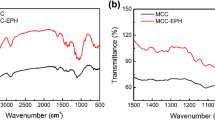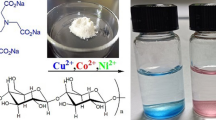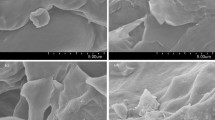Abstract
A cross-linked cellulose-amine polymer composed of nanocrystalline cellulose and 1,4-pheneylnediamine was synthesized, and its application as an adsorbent of metal ions from wastewater was dementated. The nanocrystalline cellulose was generated from an olive industry solid waste. The cross-linked polymer analysis results of FTIR, NMR, TEM, SEM, and XRD were generated. The adsorption efficiency of the cellulose-amine polymer toward Cu(II) and Pb(II) was investigated as a function of adsorbent dose, temperature, pH, and time. The adsorption parameters that lead to an excellent adsorption efficiency were determined. The polymer also showed an excellent extraction efficiency toward 20 metal ions present in a sewage sample. The various functional groups present on polymer surface such as amino, hydroxyl, and aryl played a crucial role on metal adsorption. Thermodynamic analysis results support the high efficiency of the polymer toward the metal ions. Kinetic study results reveal that the adsorption process fits well with the pseudo-second-order model and the adsorption isotherm follows a Langmuir isotherm model.






Similar content being viewed by others
References
Abdel-Ghani NT, Hefray M, EL-Chaghaby GAF (2007) Removal of Lead from aqueous solution using low cost abundantly available adsorbent. Int J Environ Sci Technol 4(1):67–73
Acar FN, Eren Z (2006) Removal of Cu(II) ions by activated poplar sawdust (Samsun clone) from aqueous solutions. J Hazard Mater 137:909–914
Adeyemo AA, Adeoye IO, Bello OS (2017) Adsorption of dyes using different types of clay: a review. Appl Water Sci 7:543–568
Algarra M, Bartolić D, Radotić K, Mutavdžić D, Pino-González MS, Rodríguez-Castellón E, Lázaro-Martínez JM, Guerrero-González JJ, Esteves da Silva JCG, Jiménez-Jiménez J (2019) P-doped carbon nano-powders for fingerprint imaging. Talanta 194:150–157
Azzaoui K, Mejdoubi E (2014) Thesis, Faculty of Sciences, Mohamed 1st University, Oujda, Morocco, 286/14
Bo S, Ren W, Lei C, Xie Y, Cai Y, Wang S, Gao J, Ni Q, Yao J (2018) Flexible and porous cellulose aerogels/zeolitic imidazolate framework (ZIF-8) hybrids for adsorption removal of Cr(IV) from water. J Solid State Chem 262:135–141
Brdar M, Šćiban M, Takači A, Došenović T (2012) Comparison of two and three parameters adsorption isotherm for Cr(VI) onto Kraft lignin. Chem Eng J 183:108–111
Chwastowski J, Staroń P, Kołoczek H, Banach M (2017) Adsorption of hexavalent chromium from aqueous solutions using Canadian peat and coconut fiber. J Mol Liq 248:981–989
Da Silva JS, Da Rosa MP, Beck PH, Peres EC, Dotto GL, Kessler F, Grasel FS (2018) Preparation of an alternative adsorbent from Acacia mearnsii wastes through Acetosolv method and its application for dye removal. J Clean Prod 180:386–394
Doan HD, Lohi A, Dang VBH, Dang-Vu T (2008) Removal of Zn+2 and Ni+2 by adsorption in a fixed bed of wheat straw. Process Saf Environ Prot 86:259–267
Guo X, Zhang S, Shan XQ (2008) Adsorption of metal ions on lignin. J Hazard Mater 151(1):134–142
Gupta S, Babu BV (2009) Utilization of waste product (tamarind seeds) for the removal of Cr(VI) from aqueous solutions: equilibrium, kinetics, and regeneration studies. J Environ Manag 90:3013–3022
Gupta VK, Nayak A, Agarwal S (2015) Bioadsorbents for remediation of heavy metals: current status and their future prospects. Environ Eng Res 20:1–18
Hamed O, Fouad Y, Hamed EM, Al-Hajj N (2012) Cellulose powder from olive industry solid waste. BioResources 7:4190–4201
Hamed O, Jodeh S, Al-Hajj N, Abo-Obeid A, Hamed EM, Fouad Y (2014) Cellulose acetate from biomass waste of olive industry. J Wood Sci 61:45–62
Heinze T, Liebert T (2001) Unconventional methods in cellulose functionalization. Prog Polym Sci 26:1689–1762
Hokkanen S, Bhatnagar A, Sillanpa M (2016) A review on modification methods to cellulose-based adsorbents to improve adsorption capacity. Water Res 91:156–173
Jodeh S, Amarah J, Radi S, Hamed O, Warad I, Salghi R, Chetouni A, Samhan S, Alkowni R (2016) Removal of methylene blue from industrial wastewater in Palestine using polysiloxane surface modified with bipyrazolic tripodal receptor. Moroc J Chem 4:140–156
Jodeh S, Hamed O, Melhem A, Salghi R, Jodeh D, Azzaoui K, Benmassaoud Y, Murtada K (2018) Magnetic nanocellulose from olive industry solid waste for the effective removal of methylene blue from wastewater. Environ Sci Pollut Res 25:22060–22074
Karnitz O Jr, Gurgel LVA, de Melo JCP (2007) Adsorption of heavy metal ion from aqueous single metal solution by chemically modified sugarcane bagasse. Bioresour Technol 98:1291–1297
Kim UJ, Kuga S, Wada M, Okano T, Kondo T (2000) Periodate oxidation of crystalline cellulose. Biomacromolecules 1:488–492
Lázaro Martínez JM, Romasanta PN, Chattah AK, Buldain GY (2010) NMR characterization of hydrate and aldehyde forms of imidazole-2-carboxaldehyde and derivatives. J Org Chem 75:3208–3213
Limousin G, Gaudet JP, Charlet L, Szenknect S, Barthès V, Krimissa M (2007) Sorption isotherms: a review on physical bases, modeling and measurement. Appl Geochem 22:249–275
Lin JX, Zhan SL, Fang MH, Qian XQ, Yang H (2008) Adsorption of basic dye from aqueous solution onto fly ash. J Environ Manag 87:193–200
Lin J, Chen X, Chen C, Hu J, Zhou C, Cai X, Wang W, Zheng C, Zhang P, Cheng J (2018) Durably antibacterial and bacterially anti-adhesive cotton fabrics coated by cationic fluorinated polymers. ACS Appl Mater Interf Sci 10:6124–6136
Milieu Ltd, WR, RPA (2010) Environmental, economic and social impacts of the use of sewage sludge on land. 266. http://ec.europa.eu/environment/waste/sludge/pdf/part_iii_report.pdf
Moa J, Yanga Q, Zhang N, Zhang W, Zheng Y, Zhang Z (2018) Review on agro-industrial waste (AIW) derived adsorbents for water and wastewater treatment. J Environ Manag 227:395–405
Muhammad RR, Nor AY, Mohammad JH, Norazowa I, Faruq M, Sazlinda K, Hamad AA (2018) Iminodiacetic acid modified kenaf fiber for waste water treatment. Int J Biol Macromol 112:754–760
Nada AMA, Eid MA, El Bahnasawy RM, Khalifa MN (2002) Preparation and characterization of cation exchangers from agricultural residues. J Appl Polym Sci 85:792–800
Nagy B, Maicaneanu A, Indolean C, Burca S, Silaghi L, Majdik C (2013) Acta Chimica. Slovenica 60:263–273
O’Connell DW, Birkinshaw C, O’Dwyer TF (2008) Heavy metal adsorbents prepared from the modification of cellulose: a review. Bioresour Technol 99:6709–6724
Qaiser S, Saleemi AR, Umar M (2009) Biosorption of lead from aqueous solution by Ficus religiosa leaves: batch and column study. J Hazard Mater 166:998–1005
Sahmoune MN, Louhab K, Boukhiar A (2011) Advanced biosorbents materials for removal of chromium from water and wastewaters. Environ Prog Sustain Energy 30:284–293
Saravanan R, Ravikumar L (2015) The use of new chemically modified cellulose for heavy metal ion adsorption and antimicrobial activities. J Water Resour Prot 7:530–545
Srinivas T, Prasad VSRK (2002) Studies on treatment of metallic effluents by non-conventional adsorbents. Ind J Env Prot 22:1226
Sud D, Mahajan G, Kaur MP (2008) Agricultural waste material as potential adsorbent for sequestering heavy metal ions from aqueous solutions-a review. Bioresour Technol 99:6017–6602
Uddin MK (2017) A review on the adsorption of heavy metals by clay minerals, with special focus on the past decade. Chem Eng J 308:438–462
Vieira MGA, De Almeida Neto AF, Da Silva MGC, Carneiro CN, DeMelo Filho AA (2014) Adsorption of lead and copper ions from aqueous effluents on rice husk ash in a dynamic system. Brazilian Journal of Chemistry Engineering 31(2): 519–529
Wang J, Liu M, Duan C, Sun J, Xu Y (2019) Preparation and characterization of cellulose-based adsorbent and its application in heavy metal ions removal. Carbohydr Polym 206:837–843
Zelić E, Vuković Z, Halkijević I (2018) Application of nanotechnology in wastewater treatment. GRAĐEVINAR 70:315–323
Zhang ZZ, Li MY, Chen W, Zhu SZ, Liu NN, Zhu LY (2010) Immobilization of lead and cadmium from aqueous solution and contaminated sediment using nanohydroxyapatite. Environ Pollut 158:514–519
Zhao X, Wang W, Zhang Y, Wu S, Li F, Liu JP (2014) Synthesis and characterization of gadolinium doped cobalt ferrite nanoparticles with enhanced adsorption capability for Congo Red. Chem Eng J 250:164–174
Acknowledgments
ARDITI-Agência Regional para o Desenvolvimento da Investigação Tecnologia e Inovação is acknowledged through the project M1420-01-0145-FEDER-000005-CQM+ (Madeira 14-20 Program). The authors also acknowledge the NM lab of SCAI (University of Málaga) for polymer analysis.
Funding
The authors received financial support from the Palestinian Ministry of Higher Education for this work.
Author information
Authors and Affiliations
Corresponding authors
Additional information
Responsible editor: Angeles Blanco
Publisher’s note
Springer Nature remains neutral with regard to jurisdictional claims in published maps and institutional affiliations.
Electronic supplementary material
ESM 1
The supplementary data file contains the FT-IR, 13C NMR, XRD spectra and thermal analysis data of cellulose and cellulose amine polymers. (DOCX 575 kb)
Rights and permissions
About this article
Cite this article
Hamed, O., Lail, B.A., Deghles, A. et al. Synthesis of a cross-linked cellulose-based amine polymer and its application in wastewater purification. Environ Sci Pollut Res 26, 28080–28091 (2019). https://doi.org/10.1007/s11356-019-06001-4
Received:
Accepted:
Published:
Issue Date:
DOI: https://doi.org/10.1007/s11356-019-06001-4




